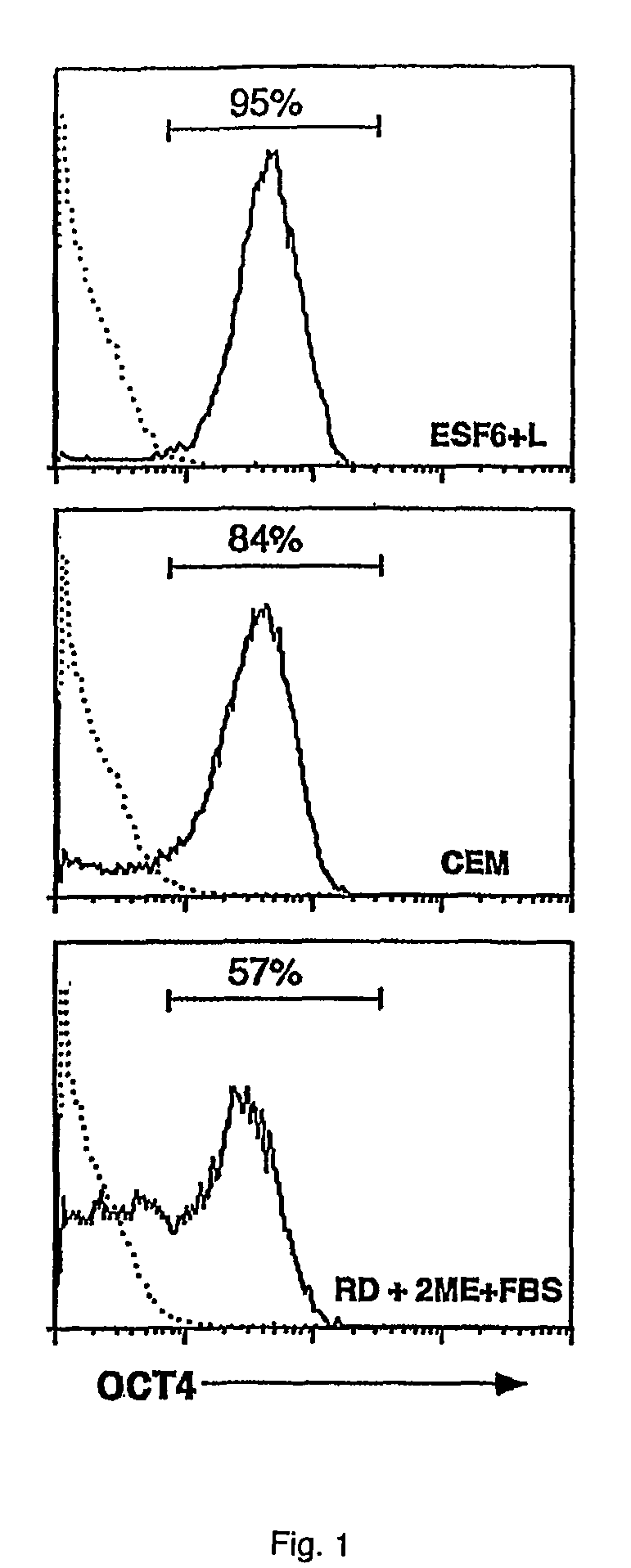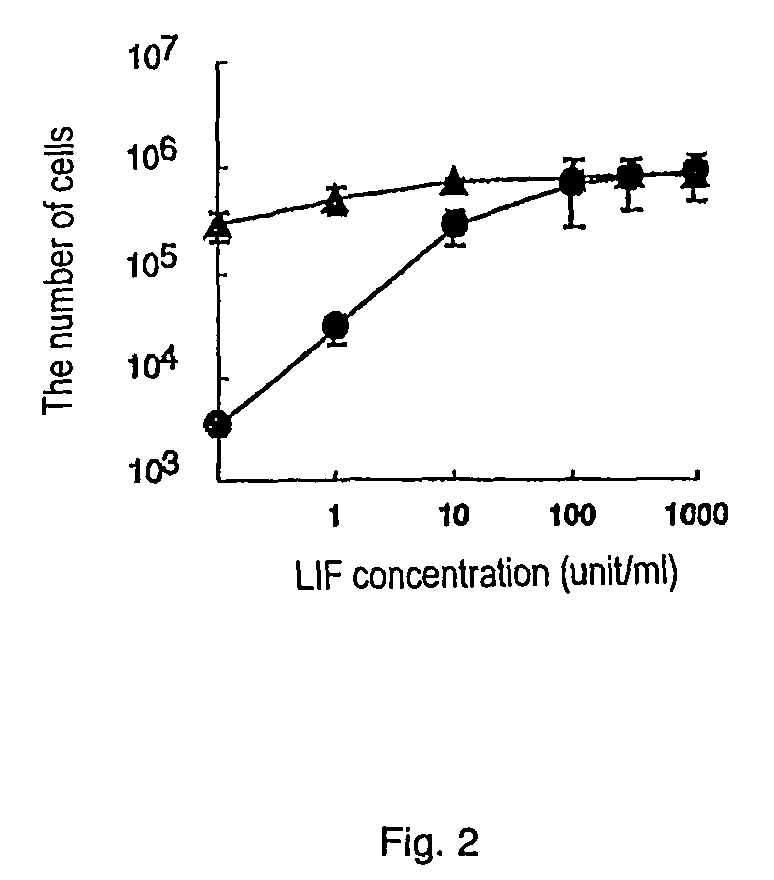Medium for ES culturing
a technology of es cells and medium, applied in the field of basic medium, can solve the problems of inability to analyze the differentiation-inducing factors correctly, the application of regenerative medicine involves a risk, and the differentiation of es cells into nerves
- Summary
- Abstract
- Description
- Claims
- Application Information
AI Technical Summary
Problems solved by technology
Method used
Image
Examples
example 1
Preparation of Basal Medium
[0025]The basal medium having composition shown by the following table (referred to as “ESF medium”) was prepared, and sterilized according to a usual method.
[0026]
ComponentsConcentration (mg / L)L-alanine2.225L-arginine50L-arginine HCl94.75L-asparagine H2O16.2525L-Asparatic acid8.325L-cysteine HCl•H2O8.78L-cystine 2HCl47.5725L-glutamic acid8.675L-glutamine549.65Glycine19.375L-histidine23.165L-hydroxyproline5L-isoleucine65.935L-leucine68.225L-lysine HCl92.175L-methionine19.87L-phenylalanine37.99L-proline13.625L-serine31.125L-threonine55.525L-tryptophan9.76L-tyrosine42.36L-valine54.825Glutathione0.25Para-aminobenzoic acid0.25Biotin0.05185Calcium pantothenate2.1825Choline chloride6.24Folic acid2.575Inositol16.85Niacinamide2.25925Pyridoxal HCl2Pyridoxine HCl0.2655Riboflavin0.2595Thiamine HCl2.335Vitamin B120.34125Hypoxanthine1.02Linoleic acid0.021Lipoic acid (thioctic acid)0.0525Putrecine dihydrochloride0.04025Thymidine0.1825Sodium chloride6599.75Potassium chlo...
example 2
Culture and Growth of ES Cells
[0027]ES-D3 (ATCC, USA) was used as an ES cell line. Though the cell can be cultured without using feeder cells, it is said that the cell exhibits a tendency to differentiation in such a case. The ES-D3 cells were maintained initially on a 0.1% gelatin-coated plate (Cell & Molecular Technologies, Inc., Phillipburg, N.J.), in Dulbecco's modified Eagle medium supplemented with 15% fetal bovine serum, L-glutamine, 0.1 mM 2-mercaptoethanol, nucleoside, nonessential amino acid, and LIF (complete ES medium; hereinafter referred to as CEM, Cell & Molecular Technologies, Inc., Phillipburg, N.J.). The composition of the CEM medium is shown below.
ES-101-B
[0028]Complete ES cell Culture Media
[0029]
PartNumberComponentSLM-220DMEM ES cell qualified, 400 mlTMS-002L-Glutamine 8 ml / 400 ml mediaES-008 4 ml nucleosides / 400 ml mediaES-007 4 ml beta-mercaptoethanol / 400 ml mediaTMS-001 4 ml NEAA / 400 ml mediaES-00960 ml FBS / 400 ml mediaLIF 4 mls LIF / 400 ml mediaTMS-AB2 4 ml Pe...
example 3
Effect of LIF Concentration
[0036]The effect of LIF on the proliferation of ES-D3 cells was examined. The ES-D3 cells were seeded at 5×103 cells / well in ESF6 (ESF+6 factors), and in RD+6F, on a type I collagen-coated 24-well plate, and in DMEM+15% FBS+2-mercaptoethanol on a gelatin-coated 24-well plate. To each well, LIF was added at 0, 1, 10, 100, 500, 1000 units / ml. After culturing 6 days, the cells were counted with a Coulter counter.
[0037]It is known that LIF maintains a self-replicating ability and an undifferentiated state of ES cells but it has no effect on cell proliferation. However, as shown in FIG. 2, LIF obviously stimulated the proliferation of ES cells in a concentration-dependent manner in the ESF6 medium (closed circle). On the other hand, LIF had little effect on cell proliferation in DMEM (closed triangle) supplemented with 15% FBS and 2-mercaptoethanol. In other words, the use of the chemosynthetic serum-free ESF6 medium of the present invention has made it possibl...
PUM
| Property | Measurement | Unit |
|---|---|---|
| concentration | aaaaa | aaaaa |
| concentration | aaaaa | aaaaa |
| concentration | aaaaa | aaaaa |
Abstract
Description
Claims
Application Information
 Login to View More
Login to View More - R&D
- Intellectual Property
- Life Sciences
- Materials
- Tech Scout
- Unparalleled Data Quality
- Higher Quality Content
- 60% Fewer Hallucinations
Browse by: Latest US Patents, China's latest patents, Technical Efficacy Thesaurus, Application Domain, Technology Topic, Popular Technical Reports.
© 2025 PatSnap. All rights reserved.Legal|Privacy policy|Modern Slavery Act Transparency Statement|Sitemap|About US| Contact US: help@patsnap.com



